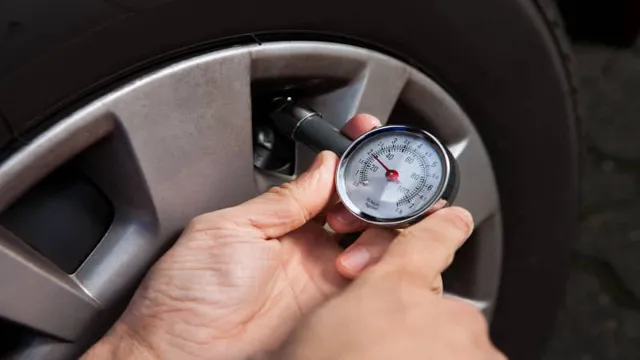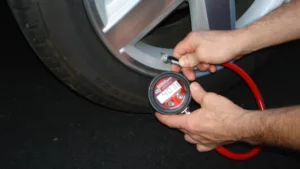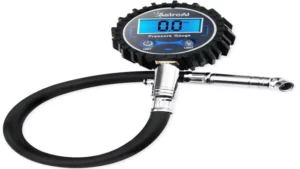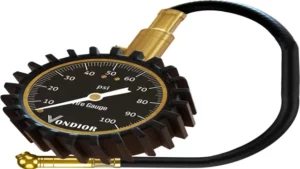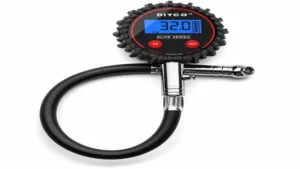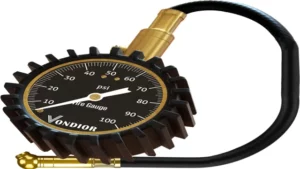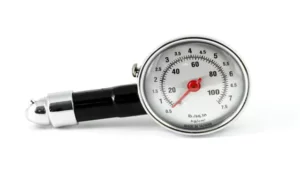If you’re a car owner, you’re probably well aware of the importance of checking your tire pressure regularly. After all, your tire pressure affects your vehicle’s performance and safety. But what about those numbers on your tire pressure gauge? What do they mean, and why are they there? Understanding the bar measurement on tire pressure gauges can be confusing at first, but it’s essential knowledge for any driver.
In this blog post, we’ll break down everything you need to know about the bar measurement on tire pressure gauges, so you can keep your tires in tip-top shape and stay safe on the road.
What is a tire pressure gauge?
If you’re new to using a tire pressure gauge, you may be wondering what the “bar” measurement means. In short, it’s a metric unit of pressure commonly used in European countries. One bar is equivalent to approximately 1
5 pounds per square inch (PSI). When using a tire pressure gauge, the bar measurement will typically be displayed alongside the PSI measurement. It’s important to note that not all gauges will have the option to switch between the two units, so be sure to check before purchasing.
Understanding the bar measurement can be helpful if you’re traveling abroad or if your vehicle’s manual recommends checking tire pressure in bar. Overall, a tire pressure gauge is a simple yet essential tool for maintaining safe and efficient driving.
Description of a tire pressure gauge
A tire pressure gauge is a device used to measure the air pressure inside a tire. It is an essential tool for any vehicle owner, as proper tire pressure is necessary for optimal performance and safety. The gauge is generally small and portable, and the mechanism includes a dial or digital display, a stem, and a pressure release valve.
To use the gauge, you simply press the stem onto the tire’s valve and read the measurement displayed. It is important to regularly check tire pressure with a gauge, as under or over-inflated tires can lead to decreased fuel efficiency, uneven tire wear, and potentially dangerous blowouts. With a tire pressure gauge, you can easily maintain the recommended pressure level for your tires, ensuring a smoother ride and a longer lifespan for your vehicle.
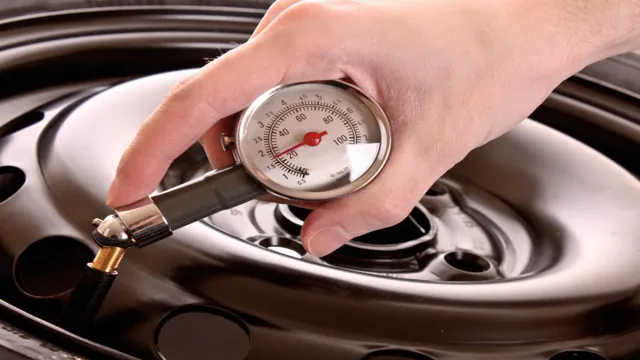
Understanding the bar measurement
If you’re someone who’s ever checked tire pressure using a gauge, you might’ve seen the term “bar” on a tire pressure gauge. The term “bar” refers to a unit of measurement that is used to express pressure. In this case, it is used to measure the amount of air pressure inside the tire.
One bar is equivalent to atmospheric pressure at sea level, which is around 15 psi (pounds per square inch). Most tire pressure gauges provide readings in both psi and bars, and it’s important to know which unit of measurement is used to ensure proper tire inflation.
So, the next time you check your tires with a gauge, make sure you pay attention to the bar measurement and ensure it matches the recommended pressure provided by the manufacturer.
Definition of bar measurement
Bar measurement refers to the method used to measure atmospheric pressure. A bar is a unit of pressure that represents the average air pressure at sea level. One bar is equal to approximately 1
7 pounds per square inch (psi) of pressure. Atmospheric pressure varies depending on factors such as altitude, weather conditions, and geography. Understanding bar measurement is important in a variety of industries, including aviation, meteorology, and scuba diving.
In aviation, barometric pressure is used to calculate altitude and to ensure safe flying conditions. Meteorologists use barometric pressure readings to predict weather patterns and track hurricanes. Scuba divers also rely on barometric pressure to calculate how long they can remain underwater without experiencing decompression sickness.
By understanding bar measurement, individuals can better understand the impact of atmospheric pressure on their daily lives.
Why bar measurements are used on tire pressure gauge
Tire pressure gauges are an essential tool for every car owner, helping to ensure that tires are properly inflated for improved safety and performance. However, understanding the difference between the different bar measurements used on tire pressure gauges can be confusing. Bar is the unit of pressure used in most countries, and it’s the most common measurement used on tire pressure gauges in Europe.
One bar is equivalent to approximately 15 PSI (pounds per square inch) and is considered within the recommended range for many vehicles. Using a tire pressure gauge that displays bar measurements can provide more accurate readings and help drivers maintain proper tire pressure, which can improve fuel efficiency, handling, and tire wear.
So, next time you check your tire pressure, make sure you understand the bar measurement and adjust your tires accordingly.
How to read the bar measurement on a tire pressure gauge
If you’ve ever checked the air pressure in your car tires, you may have come across the unit of measurement called “bar” on your tire pressure gauge. So what does bar mean on a tire pressure gauge? Simply put, a bar is a unit of pressure measurement that is commonly used in Europe and other parts of the world. One bar is equal to approximately 1
5 pounds per square inch (psi) and is often represented as “bar” or “bars” on a tire pressure gauge. When using a tire pressure gauge, you’ll typically see a range of numbers and markings that correspond to different pressure measurements, including bar, psi, and kilopascals (kPa). To accurately read the bar measurement on a tire pressure gauge, ensure that the gauge is properly calibrated and use the gauge to measure the pressure in your tires while they are cold for the most accurate reading.
Instructions on how to read the bar measurements
When it comes to checking tire pressure, it’s important to know how to read the bar measurements on a tire pressure gauge. Bar measurements indicate the amount of pressure within the tire, and they are typically displayed in increments of 0.1 bar.
To read the bar measurements, first, determine the recommended tire pressure for your vehicle. This information can typically be found in your owner’s manual or on a sticker inside the driver’s side door. Once you know the recommended pressure, simply attach the tire pressure gauge to the valve stem on your tire and read the measurement displayed.
If the measurement is below the recommended pressure, you’ll need to add air to your tires. On the other hand, if the measurement is above the recommended pressure, you’ll need to remove some air. Overall, knowing how to read tire pressure bar measurements is an essential skill for maintaining optimal tire performance and safety on the road.
Alternative pressure measurement units
“What does bar mean on a tire pressure gauge?” If you’re unfamiliar with bar as a pressure unit, you’re not alone. Bar is a metric unit of pressure commonly used in Europe, but it’s not as common in the United States, where PSI (pounds per square inch) is the standard unit. One bar is roughly equivalent to 1
5 PSI. However, if you encounter a tire pressure gauge that includes bar measurements, don’t panic. It’s still easy to convert from bar to PSI or other units.
On most tire pressure gauges, you’ll find multiple measurements, including bar, PSI, and kPa (kilopascal). Simply use a conversion chart or calculator to convert the measurement to the unit you’re most comfortable with. It’s important to find a pressure unit that you understand and use consistently, as maintaining the proper tire pressure is critical to vehicle safety and performance.
Different pressure measurement units
When it comes to measuring pressure, there are multiple units that different fields use. The most common unit is pounds per square inch (PSI), which is widely used in fields like aviation, automotive industry, and hydraulics. However, scientists and researchers generally use pascals (Pa), which is the International System of Units (SI) unit for pressure.
Another pressure measurement unit that is commonly used is bar, which is used mainly in Europe. Moreover, kilopascals (kPa) are frequently used in the field of medicine to measure blood pressure. It is essential to understand the different units used to measure pressure, and their conversions, to ensure accurate readings and avoid any confusion.
Comparison of bar measurement to other pressure units
When it comes to measuring pressure, there are several units of measurement available, including pascals, pounds per square inch, and atmospheres. One common unit of measurement is the bar, which is equal to 100,000 pascals or approximately 15 pounds per square inch.
While each unit has its own advantages, using bars may be preferable for certain applications. For example, it’s often used in weather forecasting since it can provide more precise measurements of air pressure changes. Conversely, pounds per square inch may be more commonly used when working with pressurized gas applications, such as in automotive or hydraulic systems.
Ultimately, choosing the right unit for the job depends on the specific needs of the application and the level of precision required.
Importance of using the correct pressure in tires
Have you ever noticed the numbers and letters on your tire pressure gauge and wondered what they meant? The letters PSI (pounds per square inch) and the numbers in BAR (the metric equivalent) are used to indicate the correct pressure for your tire. It’s important to use the correct pressure in your tires because it affects your car’s performance and safety. Overinflated tires can cause the car to handle poorly and lead to a bumpy ride.
On the other hand, underinflated tires can cause your car to pull to one side or lead to faster and uneven tire wear. By finding out what bar means on a tire pressure gauge and making sure your tires are properly inflated, you’ll save money on fuel and extend your tire’s life. Don’t underestimate the importance of paying attention to your tire’s pressure.
Conclusion
In conclusion, the bar on a tire pressure gauge is not a milky white drink served at your local pub, but rather a unit of pressure commonly used in Europe. So the next time you’re checking your tire pressure, don’t reach for a frosty mug, grab your gauge and make sure your tires are properly inflated in bar or any other unit that suits your fancy.”
FAQs
1. What is tire pressure and why is it important to maintain it?
Tire pressure refers to the amount of air pressure inside a tire, and it is important to maintain it for safety, fuel efficiency, and tire longevity.
2. How do you use a tire pressure gauge and what is the purpose of the bar measurement?
To use a tire pressure gauge, remove the valve cap on your tire, press the gauge onto the valve stem, and read the measurement. The bar measurement is a unit of pressure commonly used in Europe and represents atmospheric pressure.
3. What is the recommended tire pressure for my car and how do I find it?
The recommended tire pressure can typically be found in your car’s owner manual, on the driver’s side doorjamb, or on the tire label. It varies based on the make and model of your car.
4. Does tire pressure affect fuel efficiency, and if so, how?
Yes, tire pressure affects fuel efficiency because underinflated tires create more rolling resistance, leading to lower gas mileage.
5. Is it safe to drive with low tire pressure, and what are the risks?
Driving with low tire pressure is not safe and can lead to decreased handling, poor braking, and tire failure.
6. Can overinflating tires be harmful, and how do I know if my tires are overinflated?
Overinflating tires can lead to uneven tread wear, reduced traction, and a rougher ride. You can check if your tires are overinflated by examining the sidewall for bulging or excessive wear in the middle of the tread.
7. How often should I check my tire pressure, and what are some tips for maintaining proper tire pressure?
It is recommended to check your tire pressure once a month and before long trips. Proper tire pressure can be maintained by keeping a tire pressure gauge in your car, inflating your tires to the recommended amount, and monitoring the pressure regularly.
